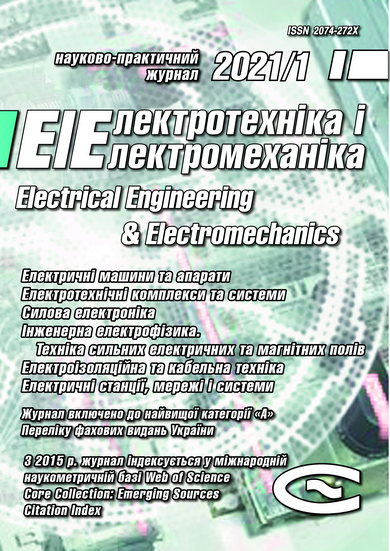Reproducing of the humidity curve of power transformers oil using adaptive neuro-fuzzy systems
DOI:
https://doi.org/10.20998/2074-272X.2021.1.02Keywords:
power transformer, transformer oil, cellulose insulation, ANFIS, modelingAbstract
Introduction. One of the parameters that determine the state of the insulation of power transformers is the degree of moisture content of cellulose insulation and transformer oil. Modern systems of continuous monitoring of transformer equipment have the ability to accumulate data that can be used to reproduce the dynamics of moisture content in insulation. The purpose of the work is to reproduce the curve of the of humidity of transformer oil based on the results of measuring the temperature of the upper and lower layers of oil without the need for direct measurement of moisture content by special devices. Methodology. The construction of a fuzzy neural network is carried out using networks based on adaptive neuro-fuzzy system ANFIS. The network generated using the Grid Partition algorithm without clustering and Subtractive Clustering. Results. The paper presents a comparative analysis of fuzzy neural networks of various architectures in terms of increasing the accuracy of reproducing the moisture content of transformer oil. For training and testing fuzzy neural networks, the results of continuous monitoring of the temperature of the upper and lower layers of transformer oil during two months of operation used. Considered twenty four variants of the architecture of ANFIS models, which differ in the membership functions, the number of terms of each input quantity, and the number of training cycles. The results of using the constructed fuzzy neural networks for reproducing the dynamics of moisture content of transformer oil during a month of operation of the transformer are presented. The reproducing accuracy was assessed using the root mean square error and the coefficient of determination. The test results indicate the sufficient adequacy of the proposed models. Consequently, the RMSE value for the network constructed using Grid Partition method was 0.49, and for the network built using the Subtractive Clustering method – 0.40509.
References
Saha T.K., Purkait P. Transformer Ageing: Monitoring and Estimation Techniques. John Wiley & Sons Singapore Pte. Ltd., 2017. doi: https://doi.org/10.1002/9781119239970.
Martin D., Saha T. A review of the techniques used by utilities to measure the water content of transformer insulation paper. IEEE Electrical Insulation Magazine, 2017, vol. 33, no. 3, pp. 8-16. doi: https://doi.org/10.1109/MEI.2017.7906158.
Liu J., Fan X., Zhang Y., Zheng H., Zhu M. Quantitative evaluation for moisture content of cellulose insulation material in paper/oil system based on frequency dielectric modulus technique. Cellulose, 2020, vol. 27. doi: https://doi.org/10.1007/s10570-019-02820-3.
Cheng J., Robalino D.M., Werelius P., Ohlen M. Advanced Technique for Moisture Condition Assessment in Power Transformers. Journal of International Council on Electrical Engineering, 2014, vol. 4. pp. 185-191. doi: https://doi.org/10.5370/JICEE.2014.4.3.185.
Sikorski W., Walczak K., Przybylek P. Moisture Migration in an Oil-Paper Insulation System in Relation to Online Partial Discharge Monitoring of Power Transformers. Energies, 2016, vol. 9, no. 12, p. 1082. doi: https://doi.org/10.3390/en9121082.
Andrienko P.D., Sakhno A.A., Konogray S.P., Skrupskaya L.S. Online Monitoring of the Insulation Water Content Characteristics of the Oilfilled Electrical Equipment. Electrical Engineering and Power Engineering, 2014, vol. 2, pp. 32-40. doi: https://doi.org/10.15588/1607-6761-2014-2-5.
Przybylek P. The influence of temperature and aging of cellulose on water distribution in oil-paper insulation. IEEE Transactions on Dielectrics and Electrical Insulation, 2013, vol. 20, no. 2, pp. 552-556. doi: https://doi.org/10.1109/TDEI.2013.6508758.
Jang J.-S.R. ANFIS: Adaptive-network-based fuzzy inference system. IEEE Transaction on Systems, Man, and Cybernetics, 1993, vol. 23, no. 3, pp. 665-685. doi: https://doi.org/10.1109/21.256541.
Prasojo R.A., Diwyacitta K., Suwarno, Gumilang H. Transformer paper expected life estimation using ANFIS based on oil characteristics and dissolved gases (Case study: Indonesian transformers). Energies, 2017, vol. 10, no. 8, p. 1135. doi: https://doi.org/10.3390/en10081135.
Aghaei J., Gholami A., Shayanfar H.A., Dezhamkhooy A. Dissolved gas analysis of transformers using fuzzy logic approach. European Transactions on Electrical Power, 2009, vol. 20, pp. 630-638. doi: https://doi.org/10.1002/etep.343.
Khan S.A., Equbal M.D., Islam T. ANFIS based identification and location of paper insulation faults of an oil immersed transformer. 2014 6th IEEE Power India International Conference (PIICON), Delhi, 2014, pp. 1-6. doi: https://doi.org/10.1109/poweri.2014.7117715.
Bin Yaacob M.M., Hussein A.R., Bin Othman M.F. DGA Method-Based ANFIS Expert System for Diagnosing Faults and Assessing Quality of Power Transformer Insulation Oil. Modern Applied Science, 2016, vol. 10, no. 1, pp. 13-22. doi: https://doi.org/10.5539/mas.v10n1p13.
Jahangir H., Hajipour E., Vakilian M., Akbari A., Blackburn T., Phung B.T. A method to capture and de-noise partial discharge pulses using discrete wavelet transform and ANFIS. International Transactions on Electrical Energy Systems, 2014, vol. 25, no. 11, pp. 2696-2717. doi: https://doi.org/10.1002/etep.1986.
Chiu S.L. Fuzzy model identification based on cluster estimation. Journal of Intelligent and Fuzzy Systems, 1994, vol. 2, no. 3, pp. 267-278. doi: https://doi.org/10.3233/ifs-1994-2306.
Downloads
Published
How to Cite
Issue
Section
License
Copyright (c) 2021 V.V. Vasilevskij, M.O. Poliakov

This work is licensed under a Creative Commons Attribution-NonCommercial 4.0 International License.
Authors who publish with this journal agree to the following terms:
1. Authors retain copyright and grant the journal right of first publication with the work simultaneously licensed under a Creative Commons Attribution License that allows others to share the work with an acknowledgement of the work's authorship and initial publication in this journal.
2. Authors are able to enter into separate, additional contractual arrangements for the non-exclusive distribution of the journal's published version of the work (e.g., post it to an institutional repository or publish it in a book), with an acknowledgement of its initial publication in this journal.
3. Authors are permitted and encouraged to post their work online (e.g., in institutional repositories or on their website) prior to and during the submission process, as it can lead to productive exchanges, as well as earlier and greater citation of published work.





